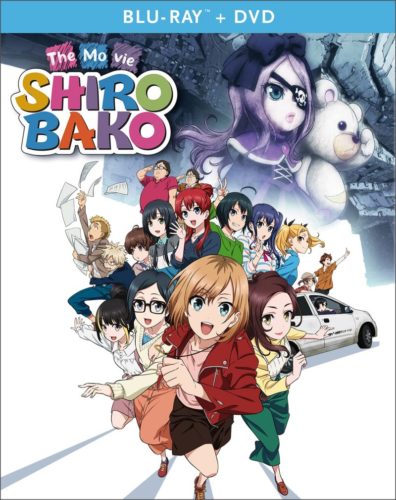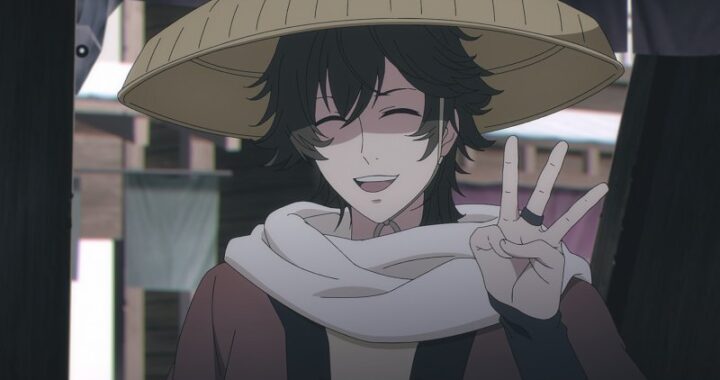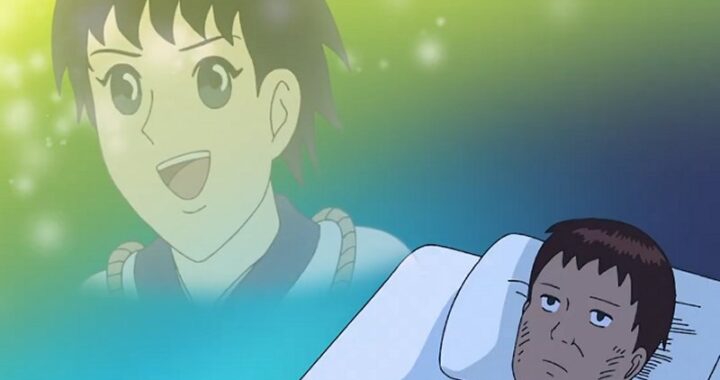 The gang is all back together – just not in the same place.
The gang is all back together – just not in the same place.
What They Say:
Four years after the events of the series, Musashino Animation has gone through unprecedented changes and things are looking bleak for the studio. One day, Aoi Miyamori is offered a role managing a new theatrical animation project. With only a few months left before the deadline, can MUSANI complete the project in its current state? It’s up to Aoi to work alongside both familiar faces and new to finish the project in time!
The Review:
Audio:
The audio presentation for this series brings us the original Japanese language track done with a 5.1 mix using the DTS-HD MA lossless codec. The film is one that has its moments of good action in a sense, mostly coming from the various in-film show sequences that deal with the projects that the studios work on, but it has some other areas that work nicely as well in giving it a bit more life. The bulk of it is very much dialogue-driven, however, and it handles that really well with everything that it does. It’s not a mix that will stand out, even when we get the in-film show sequences, but it works the soundstage well for the dialogue in general. While not a rich mix we do get one that’s well put together and enjoyable, especially when there are multiple characters on screen at a time and the conversation moves about them in a very good way.
Video:
Originally airing in theaters in 2020, the transfer for this feature film is presented in its original aspect ratio of 1.78:1 in 1080p using the AVC codec. Animated once again by PA Works, the quality is definitely here from start to finish in something that’s richly detailed, beautifully colored, and has some great blending of CG when needed. The TV series really stood out well and the film basically carries that over here so there are no real differences between the two, which says a lot about the quality of the TV show. There’s a labor of love element to this property to be sure and it really does shine through with the look of it. The backgrounds are fantastic, the changes in character costuming is a big plus for me, and the detail and variety in the designs is just as strong. All of this comes through beautifully in the transfer with great colors and wonderful representation of detail, making it a fully engaging experience. With the fully realized world that we get here, it’s important to have a strong transfer and this one pays it off.
Packaging:
The packaging for this release brings us a standard-sized Blu-ray case with an o-card included that mirrors the case artwork itself. The front cover uses the familiar poster visual for the film as we get the main cast spread across it and a good bit of white space. The o-card comes across bright and sharper than the case itself thanks to the cardstock and it definitely catches the eye nicely with its variety, especially as it keeps the logo a little smaller and to the upper left so that it doesn’t obscure anything. The back cover works some decent angles to bring in a good range of images and a look at the variety that the film really does engage in but it manages to not look too busy with how it’s all placed together and the color design to bind it. The summary of the premise captures the story pretty well while not giving away too much of it. The bottom brings out a clear look at the production credits and the technical information, both of which look good and covers everything in a clean and easy to read fashion. The reverse side gives us a logo-free visual one side and a cute one on the other. We also get a little four-panel booklet that breaks out the cast and a little bit of setting artwork..
Extras:
The only extras included with this release are some of the promotional material with the trailers and TV commercials and the like. It’s simple but always welcome material to be included.
The original Shirobako series was one that gained a lot of fans from the first episode through its two-cour and there’s always been some level of disappointment that we never got more. What we did get in early 2020 – just days before the world largely shut down from COVID-19, was a theatrical film for the project. It essentially brought everyone back and reminded us just how strong the animation and designs were from P.A. Works that it looked as fantastic as it does on both the big screen and through the TV series. The film took some time to finally make its way here through the pandemic but its arrival is very welcome at this point, especially as there’s a continuing greater awareness about how the things we enjoy are made and the structural problems within the industry.
The film takes place a few years after the series, giving our really expansive cast of characters a chance to change and grow some. Miyamori is still our way into this world as she continues to work at Musashino Animation and she’s still, comically enough, working that old white car as best as she can to get the job done. She’s doing well as a producer now in how she manages the staff and team under her purview and making sure all the right things are falling into place. The problem is that Musashino itself feels like a lifeless shell of what it was. A number of the employees are still there but there’s been significant changes in management and elsewhere over time, and attrition to other studios, that it doesn’t have quite the same bounce in its step nor the energy. It has that air of a business that’s about to be downsized further or is just waiting for the real final nail to be hit so that it closes.
That’s not to say they aren’t working, as they’re involved in doing some subcontracting work for a show but the whole thing feels hollow and not something that they’re truly invested in as one of their own projects. They’re getting things done but there’s frustration from some that they’re putting in too much effort, such as on the technical side with the fighter planes, that it breaks from the overall style of the show itself. We see supervisors and the like still looking to teach and draw the staff into the right way of doing things, but the push and pull of deadlines and demands are still there as well. So the familiar pieces remain in the right ways but it has that overcast layer of somberness to it that really does make an impact.
Some of what comes from this is natural as we don’t have the wide-eyed innocence of Miyamori as she intends to change the anime world but also with Sakaki as she’s doing her voice work but still has a kind of imposter syndrome thing going on and doesn’t quite feel like she’s in the industry. The others from the old school club, who she gets together with from time to time still, all have elements of this though they do keep encouraging each other and try to paper over the issues that they’re failing themselves. As I said, a lot of this is part of the natural evolution of working in your field of choice, especially when you don’t have full control, but it’s also going from newly-graduated college kids to people now moving into their late-twenties and having to make decisions about their lives and the paths that they’re on.
This isn’t limited to just that group as we see it across other cast members as well, with some having moved on to completely different fields, like a cake shop or working a small bar, and that helps to make clear that the kind of malaise that one can feel in their twenties isn’t unique to that. You can feel it through your entire life, but it comes with a different kind of wisdom and view of how to handle and manage it. With Miyamori being our window into the world, it’s predominantly about her age set but by bringing in the others and making it clear that it’s not just a twenties thing, it works far better and more honestly about the situation. And this does make a good chunk of the movie a little hard to watch because we had spent a two-cour series watching them work hard, fail often, but overcome some significant challenges with seemingly boundless energy. This more honest view of what things are like when events like this happen is totally in line with the series and property as a whole, but it may not be exactly what fans are looking for when they excitedly grab the release.
But this is all required because the second half begins a kind of revival of sorts, to show that there are paths – often completely unexpected – that come about for reasons that are often out of your own control. Watching as life is breathed back into the animation studio and a few familiar faces return to it as well is really exciting to watch, especially since all of the characters have grown and changed and aren’t who they were four years prior. Through it, we see how Miyamori has a better leading role to bring them to where they need to be but without going it alone. There are a lot of really fun and silly moments that come into this, often with director Kinoshita, but he’s always been a real mixed bag in just how much of his antics and style I can take. But through the design of the film we’re watching, it’s mitigated nicely and there’s a nostalgia to it as all of these pieces come together to deliver a good capstone to the Shirobako world.
In Summary:
I love the world of Shirobako as it really does the best in showing how the world of animation is in Japan. Of course, there are things that are played up or played down and some aspects are just hard to get across into a story and series. With this film, I’m really glad that it didn’t deliver what I expected but rather gave me a story and series of events to play out that shows the struggles of this field, these people, and this studio among other things. There are so many moving parts here with so many characters, which is what made the series so much fun but also a bit hard at times, and that carries through here. But seeing the way it unfolds and grows and shifts gears as it moves into the second half and capitalizes on all that it has built since that first episode is just magical overall. This release is pretty solid all-around with what it does, even if I’m not a fan of split licenses. The end result is that I’m thrilled to have finally gotten to see this and to have more of this cast of silly people and their lives.
Features:
Japanese DTS-HD MA 5.1 Language, English Subtitles, Promos, TV Spots
Content Grade: B+
Audio Grade: B+
Video Grade: A
Packaging Grade: B+
Menu Grade: B
Extras Grade: B-
Released By: Eleven Arts / Shout! Factory
Release Date: December 7th, 2021
MSRP: $26.98
Running Time: 119 Minutes
Video Encoding: 1080p AVC
Aspect Ratio: 1.78:1 Widescreen
Review Equipment:
Sony KDL70R550A 70″ LED 1080P HDTV, Sony PlayStation3 Blu-ray player via HDMI set to 1080p, Onkyo TX-SR605 Receiver and Panasonic SB-TP20S Multi-Channel Speaker System With 100-Watt Subwoofer.




